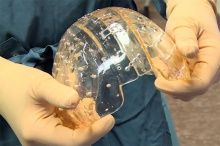3D printed skull replacement implanted for the first time ever

The patient suffered from a rare bone condition that would have killed her if left unchecked.
"The woman has her eyesight back. She is back to work and it is nearly impossible to see she was ever operated on," said Verweij.
Dr Bon Verweij and his team from UMC Utrecht perform the operation. Credit: Holladse Hoogte/PA ImagesThis is a remarkable use of 3D-printing in medicine, but it is only a single example of how the technology’s capacity to quickly and cheaply prototype custom parts is helping patients all over the world.
Doctors are working on 3D-printing everything from prosthetics such as noses and eyes to human skin that replicates not skin tone of the patient but also the surface textures, including wrinkles and veins.
For a closer look at the successful skull transplant performed in Holland you can watch the video below, but be warned: there's graphic images and a fair bit of brain matter on display.







